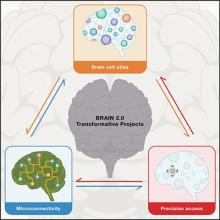
BRAIN Initiative Director Dr John Ngai provides a Leading Edge overview of three ambitious “BRAIN 2.0 transformative projects” – a comprehensive human brain cell atlas project, the BRAIN microconnectivity project, and the precision access to brain cell types project – which promise to revolutionize how researchers study the brain.
At its inception in 2013, the U.S. Brain Research Through Advancing Innovative Neurotechnologies (BRAIN) Initiative was charged with the development of new tools needed for making significant advances in our understanding of the human brain. Under the aegis of the National Institutes of Health (NIH) BRAIN Initiative, the NIH has invested about $2.4 billion dollars since 2014, which have led to the innovation of a suite of new tools and technologies for studying human and non-human neural circuits. These investments have been guided by a strategic vision laid out in 2014 in a report titled BRAIN 2025, written by a working group of NIH’s advisory committee to the director (ACD).
In 2019, new BRAIN Initiative 2.0 reports issued by the ACD BRAIN Initiative Working Group 2.0 recommended investments in a set of large-scale projects that could potentially lead to major advances in our understanding of how the brain operates. With an additional $2.6 billion dollars available through 2026, based on recommendations from the BRAIN 2.0 reports, the NIH BRAIN Initiative has embarked on a new phase and unveiled three large “BRAIN 2.0 transformative projects.”
In his Leading Edge commentary in the journal Cell, Dr. Ngai provides the historical and technological context that led to these projects, as well as a conceptual framework for how the three projects aim to address gaps in the current toolkit available to neuroscientists and the vast network of investigators in other fields whose work intersects with this space. Dr. Ngai also outlines the potential for these projects to reshape the technology toolkit available to the next generation of researchers for understanding the brain and alter the landscape of interventions available for human circuit disorders.
Read the full article here.
Image credit: Cell
